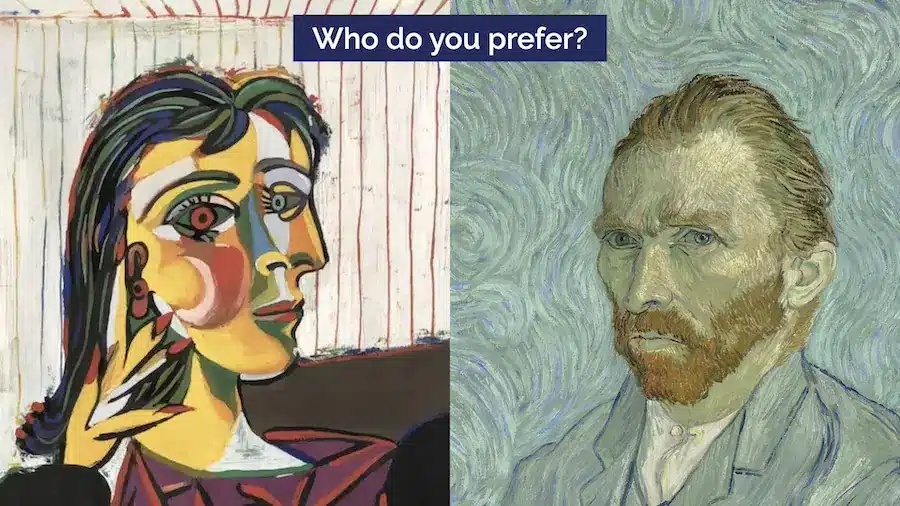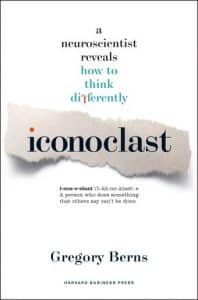I studied neuroscience to discover the super skill you need to skyrocket your business innovation results.
It’s the reason Van Gogh was broke when he died whereas Picasso left an estate worth $750 million.
Plus I’ll share seven ways you can build this super skill today to skyrocket your business innovation results.
The Big Innovation Questions
Gregory Berns is a neuroscientist. And he wrote a great book about the neuroscience of personal innovation: Iconoclast – A Neuroscientist Reveals How to Think Differently.
He asked the question: Why do some innovations thrive and others die?
And the deeper question: Why do some people become successful innovators and others fail?
Vincent Van Gogh or Pablo Picasso?
Who do you prefer – Vincent Van Gogh or Pablo Picasso?

As for me, I like Van Gogh, but I love Picasso. (I’ve created quite a few artworks based on Picasso’s work, but so far none based on Van Gogh’s work.)
Did you know that Picasso was a millionaire by the age of 27? And that when he died he left an estate worth $750 million? In contrast, Van Gogh sold only one painting in his lifetime, had his living expenses paid for by his brother and he died broke.
What made the difference here? We have two famous artists and icons of the art world, but one dies with no money at all and the other leaves behind a fortune.
The key difference between these two is the super skill you need to skyrocket your business innovation. It’s the difference between your ideas thriving or dying. And it’s the difference between you becoming a great innovator or not.
What are the key differences between Van Gogh and Picasso?
Van Gogh had a short but prolific painting career. It lasted only 9 years but during this time he produced around 2000 artworks. That’s four paintings a week.
In contrast, Picasso started painting when he was seven years old. He was tutored by his father who was an art professor. And Picasso lived until he was 91.
That’s a 9-year career versus over 80 years. Clearly, that was an advantage for Picasso. But it doesn’t explain that Picasso was a millionaire by the age of 27. What other factors were there?
Unfortunately, Van Gogh is best known for chopping off his ear. He suffered from mental illness and he died from a self-inflicted gunshot wound at the age of 37.
In contrast, Picasso was one of the world’s first art celebrities. He was well-known and well-connected. Besides his art, Picasso was known for the women in his life. He had two wives and many mistresses.
Solo or Social Success?
By definition, an iconoclast or an elite innovator begins their journey alone. Everything starts with a fresh perspective or a new way of seeing things. You must start by thinking and creating for yourself. And you must start thinking and creating in new ways.
But to be successful you need other people. You must build a community of people who share your point of view. Or, at the least, have someone build this community for you.
Without this, your ideas can’t grow and your business or innovations will never sustain themselves. You’ll be broke like Van Gogh.
Two Things to Build for Innovation Success
There are two things here that you need to skyrocket your results. You need social intelligence and you need to build a social network.
And this is where neuroscience and Gregory Berns can help. He suggests two things that are both hard-wired in your brain.

The second is reputation. Your reputation is based on trust, fairness and reciprocity. This can be mapped to specific parts of the brain. Back in caveman times, this was crucial for your physical survival, today it’s crucial for your social survival and success.
It comes down to this – we have a better chance of surviving – and being successful -when we help each other. This requires a balance of self-interest and fairness across the short and long term. If your reputation precedes you in a positive way this will help spread your ideas and grow your capacity as an innovator.
Seven Actions to Take to Skyrocket Your Innovation Results
Now for the big question. How can you use familiarity and reputation to skyrocket your innovation results? Here are seven actions you can take today.
1 Recruit a Connector
While you need to be able to sell your ideas, you can recruit someone to do this for you. Make a decision, are you going to become a connector or recruit someone else to do it for you? Neither is a perfect solution, both have their pros and cons.
2 Be Prolific
When you’re highly productive you create a presence. It gives more people a chance to run into your work which means they’ll become more familiar with your work. And this means they’re more likely to trust you and support you. Commit to being prolific.
3 – Build your Brand
But do it the right way. First, be distinctive. Be you. Be different and people will be drawn to you. Second, follow Steve Martin’s advice: “Be so good they can’t ignore you”. The wrong way to do this is to jump onto social media and start telling everyone how good you are. Don’t talk about yourself. Instead, be your brand and let your great work speak for you.

4 Create Connections
Find ways to connect what you do to others. McDonald’s founder Ray Kroc, invented Ronald McDonald because a clown was a great way to connect with children. And he knew a kid-friendly clown would attract families to his restaurants.
5 Use Metaphors
Use metaphors and analogies to connect what you do to what people know. For instance, AI is like having your own personal assistant.
6 Be Fair
The key principle for a good reputation is to act as if you will meet the person again in the future. And presume the other person will remember how you behaved. Play the long-term game rather than the short-term grab.
7 Share
If you want to be seen as an innovator and a leader among your clients and colleagues, you need to share yourself and what you create. This will help build conversations relationships and ultimately your social influence. An easy way to start is to share this blog post and video with them and start a conversation.
More on How to Grow Your Business Innovation Results
To become an innovator and grow your business innovation results, here are three related posts you might want to read next:



